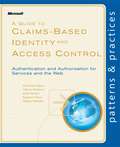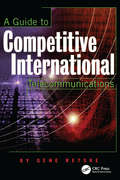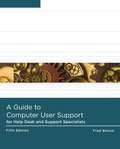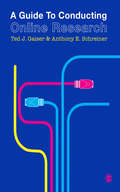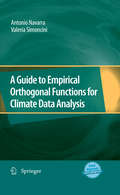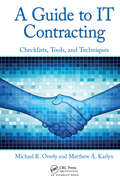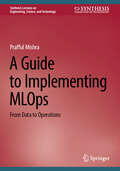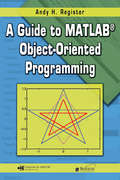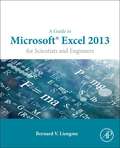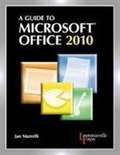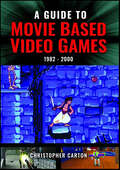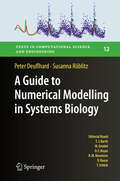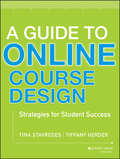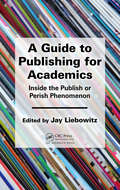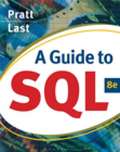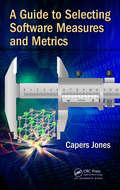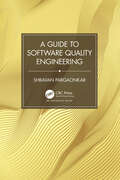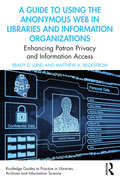- Table View
- List View
A Guide to Claims-Based Identity and Access Control
by Dominick Baier Vittorio Bertocci Keith Brown Matias Woloski Eugenio PaceAs systems have become interconnected and more complicated, programmers needed ways to identify parties across multiple computers. One way to do this was for the parties that used applications on one computer to authenticate to the applications (and/or operating systems) that ran on the other computers. This mechanism is still widely used-for example, when logging on to a great number of Web sites. However, this approach becomes unmanageable when you have many co-operating systems (as is the case, for example, in the enterprise). Therefore, specialized services were invented that would register and authenticate users, and subsequently provide claims about them to interested applications. Some well-known examples are NTLM, Kerberos, Public Key Infrastructure (PKI), and the Security Assertion Markup Language (SAML). Most enterprise applications need some basic user security features. At a minimum, they need to authenticate their users, and many also need to authorize access to certain features so that only privileged users can get to them. Some apps must go further and audit what the user does. On Windows®, these features are built into the operating system and are usually quite easy to integrate into an application. By taking advantage of Windows integrated authentication, you don't have to invent your own authentication protocol or manage a user database. By using access control lists (ACLs), impersonation, and features such as groups, you can implement authorization with very little code. Indeed, this advice applies no matter which OS you are using. It's almost always a better idea to integrate closely with the security features in your OS rather than reinventing those features yourself. But what happens when you want to extend reach to users who don't happen to have Windows accounts? What about users who aren't running Windows at all? More and more applications need this type of reach, which seems to fly in the face of traditional advice. This book gives you enough information to evaluate claims-based identity as a possible option when you're planning a new application or making changes to an existing one. It is intended for any architect, developer, or information technology (IT) professional who designs, builds, or operates Web applications and services that require identity information about their users.
A Guide to Competitive International Telecommunications
by Gene RetskeThis book provides vital information on the business, technical, legal and practical considerations in the 'New Telecom World Order'. The book offers a complete overview of the new technologies and marketing methods that new competitors are using around t
A Guide to Computer User Support for Help Desk and Support Specialists
by Fred BeisseCurrent or future user-support professionals discover the critical people skills and exceptional technical knowledge to provide outstanding support with Beisse's A GUIDE TO COMPUTER USER SUPPORT FOR HELP DESK AND SUPPORT SPECIALISTS, 5E. This useful guide focuses on the informational resources and technical tools needed most to function effectively in a support position. Readers learn to handle troubleshooting and problem solving, successfully communicate with clients, determine a client's specific needs, train end-users and even handle budgeting and other management priorities. This edition prepares readers to work with the latest developments, from Web and e-mail-based support to Windows 7 and cloud computing. Leading HelpSTAR and Microsoft Office Project Professional 2010 software accompanying the text further reinforce user-support knowledge and skills.
A Guide to Conducting Online Research
by Ted J Gaiser Anthony E SchreinerA Guide to Conducting Online Research is designed to support students, academics and research practitioners in using technology to conduct their research. The book begins by looking at what questions to ask and how to prepare to conduct online research, then concentrates on particular technologies and how to employ them effectively, before concluding with a discussion of the peculiarities of conducting research in the online environment. Practical advice is offered on common issues and problems, such as: - How to decide which application is best for your research purposes? - What can be done to guarantee the anonymity of research participants? - What kinds of challenges do firewalls present and how can they be mitigated? A Guide to Conducting Online Research provides a wealth of advice, explanation, instruction, self-help tips and examples, making this a helpful resource for anyone using technology in conducting their research.
A Guide to Empirical Orthogonal Functions for Climate Data Analysis
by Valeria Simoncini Antonio NavarraClimatology and meteorology have basically been a descriptive science until it became possible to use numerical models, but it is crucial to the success of the strategy that the model must be a good representation of the real climate system of the Earth. Models are required to reproduce not only the mean properties of climate, but also its variability and the strong spatial relations between climate variability in geographically diverse regions. Quantitative techniques were developed to explore the climate variability and its relations between different geographical locations. Methods were borrowed from descriptive statistics, where they were developed to analyze variance of related observations-variable pairs, or to identify unknown relations between variables. A Guide to Empirical Orthogonal Functions for Climate Data Analysis uses a different approach, trying to introduce the reader to a practical application of the methods, including data sets from climate simulations and MATLAB codes for the algorithms. All pictures and examples used in the book may be reproduced by using the data sets and the routines available in the book . Though the main thrust of the book is for climatological examples, the treatment is sufficiently general that the discussion is also useful for students and practitioners in other fields. Supplementary datasets are available via http://extra.springer.com
A Guide to IT Contracting: Checklists, Tools, and Techniques
by Michael R. Overly Matthew A. KarlynEven leading organizations with sophisticated IT infrastructures and teams of lawyers can find themselves unprepared to deal with the range of issues that can arise in IT contracting. Written by two seasoned attorneys, A Guide to IT Contracting: Checklists, Tools, and Techniques distills the most critical business and legal lessons learned through
A Guide to Implementing MLOps: From Data to Operations (Synthesis Lectures on Engineering, Science, and Technology)
by Prafful MishraOver the past decade, machine learning has come a long way, with organisations of all sizes exploring its potential to extract valuable insights from data. However, despite the promise of machine learning, many organisations need help deploying and managing machine learning models in production. This is where MLOps comes in. MLOps, or machine learning operations, is an emerging field that focuses on the deployment, management, and monitoring of machine learning models in production environments. MLOps combines the principles of DevOps with the unique requirements of machine learning, enabling organisations to build and deploy models at scale while maintaining high levels of reliability and accuracy. This book is a comprehensive guide to MLOps, providing readers with a deep understanding of the principles, best practices, and emerging trends in the field. From training models to deploying them in production, the book covers all aspects of the MLOps process, providing readers with the knowledge and tools they need to implement MLOps in their organisations. The book is aimed at data scientists, machine learning engineers, and IT professionals who are interested in deploying machine learning models at scale. It assumes a basic understanding of machine learning concepts and programming, but no prior knowledge of MLOps is required. Whether you're just getting started with MLOps or looking to enhance your existing knowledge, this book is an essential resource for anyone interested in scaling machine learning in production.
A Guide to MATLAB Object-Oriented Programming
by Andy H. RegisterA Guide to MATLAB Object-Oriented Programming is the first book to deliver broad coverage of the documented and undocumented object-oriented features of MATLAB. Unlike the typical approach of other resources, this guide explains why each feature is important, demonstrates how each feature is used, and promotes an understanding of
A Guide to MATLAB®
by Brian R. Hunt Ronald L. Lipsman Jonathan M. RosenbergThis book is a short, focused introduction to MATLAB, a comprehensive software system for mathematics and technical computing. It should be useful to both beginning and experienced users. It contains concise explanations of essential MATLAB commands, as well as easily understood instructions for using MATLAB's programming features, graphical capabilities, and desktop interface. It also includes an introduction to SIMULINK, a companion to MATLAB for system simulation. Written for MATLAB 6, this book can also be used with earlier (and later) versions of MATLAB. This book contains worked-out examples of applications of MATLAB to interesting problems in mathematics, engineering, economics, and physics. In addition, it contains explicit instructions for using MATLAB's Microsoft Word interface to produce polished, integrated, interactive documents for reports, presentations, or on-line publishing. This book explains everything you need to know to begin using MATLAB to do all these things and more. Intermediate and advanced users will find useful information here, especially if they are making the switch to MATLAB 6 from an earlier version.
A Guide to MATLAB® for Beginners and Experienced Users
by Brian R. Hunt Ronald L. Lipsman Jonathan M. RosenbergHere is a short, focused introduction to MATLAB, a comprehensive software system for mathematics and technical computing that should be useful to both beginning and experienced users. It contains concise explanations of essential MATLAB commands, as well as easily understood instructions for using MATLAB's programming features, graphical capabilities, and desktop interface. It also includes an introduction to SIMULINK, a companion to MATLAB for system simulation. Written for MATLAB 6, this book can also be used with earlier (and later) versions of MATLAB. Chapters contain worked-out examples of applications of MATLAB to interesting problems in mathematics, engineering, economics, and physics. In addition, it contains explicit instructions for using MATLAB's Microsoft Word interface to produce polished, integrated, interactive documents for reports, presentations, or on-line publishing. This book explains everything you need to know to begin using MATLAB. Intermediate and advanced users will find useful information here, especially if they are making the switch to MATLAB 6 from an earlier version.
A Guide to Microsoft Excel 2013 for Scientists and Engineers
by Bernard V. LiengmeThis text provides a tutorial to using the functions of Microsoft Excel, guiding the reader from basic principles through to more complicated areas such as formulae, charts, curve-fitting, equation solving, integration, macros, statistical functions, and presenting quantitative data.
A Guide to Microsoft Office 2007 for Information and Communications Technologies
by Beth Brown Elaine Malfas Jones Jan MarrelliNIMAC-sourced textbook
A Guide to Microsoft Office 2010
by Jan MarrelliA Guide to Microsoft Office 2010 focuses on teaching students business application software, including word processing, spreadsheet, database, desktop publishing, presentation graphics, and business-oriented utilization of the Internet through a project-based, hands-on approach. It also introduces computer terminology, hardware, software, operating systems, and information systems as they relate to the business environment.
A Guide to Microsoft Office 2010
by Jan MarrelliThe primary objective in this text is to teach 21st century skills through a project-based, hands-on approach. To meet this objective, we correlated the text to the National Standards for Business Education and used our teaching experiences, as well as the feedback, comments, and suggestions from other experienced educators to determine how best to present application concepts.
A Guide to Movie Based Video Games, 1982–2000
by Christopher CartonExplore two decades of licensed video games based on blockbuster movies! You’ve seen the movie, now PLAY the movie! Long before gaming came to the big screen, cinema arrived in the homes of millions in the form of licensed video games; playable merchandise that tied in to some of the major tentpoles of cinematic history. Many of these games followed the storylines of the movies on which they were based, as well as providing supplementary adventures to major franchises. Collected in this book are some of the biggest games to come from Hollywood adventures during the '80s and '90s. In this comprehensive book, you’ll find over 300 games across 18 chapters, with sections dedicated to major movie franchises such as Star Wars, Jurassic Park, Top Gun, Pixar, Aliens and Indiana Jones, along with nearly 200 full-color screenshots of major releases. Showcasing the highs and lows of early computer gaming through the 16-bit era and onto the advent of 3D console gaming, A Guide to Movie Based Video Games: 1982 - 2000 covers two decades of video games with trivia, analysis and recommendations. Grab your controller, step into the silver screen and get ready to play!
A Guide to Numerical Modelling in Systems Biology (Texts in Computational Science and Engineering #12)
by Peter Deuflhard Susanna RöblitzThis book is intended for students of computational systems biology with only a limited background in mathematics. Typical books on systems biology merely mention algorithmic approaches, but without offering a deeper understanding. On the other hand, mathematical books are typically unreadable for computational biologists. The authors of the present book have worked hard to fill this gap. The result is not a book on systems biology, but on computational methods in systems biology. This book originated from courses taught by the authors at Freie Universität Berlin. The guiding idea of the courses was to convey those mathematical insights that are indispensable for systems biology, teaching the necessary mathematical prerequisites by means of many illustrative examples and without any theorems. The three chapters cover the mathematical modelling of biochemical and physiological processes, numerical simulation of the dynamics of biological networks and identification of model parameters by means of comparisons with real data. Throughout the text, the strengths and weaknesses of numerical algorithms with respect to various systems biological issues are discussed. Web addresses for downloading the corresponding software are also included.
A Guide to Online Course Design: Strategies for Student Success
by Tina Stavredes Tiffany HerderA Guide to Online Course Design offers faculty and professional staff a practical and easy-to-follow model for creating exceptional online courses that focuses on quality standards in instructional design, transparency in learning outcomes, and learner persistence. A comprehensive resource, the book includes effective, research-based instructional strategies to motivate online learners and help them become more self-directed. A Guide to Online Course Design emphasizes quality standards and removing barriers to learners’ persistence, which ensures online courses meet the needs of online learners as well as distance education initiatives. “All faculty members and course designers, regardless of experience level, content background, or technology skills, can benefit from applying the approaches defined in this book. The authors have imparted a wealth of knowledge that can improve the quality of any online class and I highly recommend this book for all those involved with online learning.” - Anton G. Camarota, faculty, University of Denver “Anyone involved in developing online courses should read this book! Packed with great insights and the research to back them up, Stavredes and Herder guide readers with practical information that will support online course development.” - Brenda Boyd, director of professional development and consulting, Quality Matters Program “The blend of theory and application makes A Guide to Online Course Design and indispensable resource for any professional seeking to create high quality, outcomes-based learning experiences. I loved the action steps that close each chapter, as they lead the reader through the entire process of course design from analysis to implementation.” - Kathe Kacheroski, dean of curriculum and instruction, Rasmussen College
A Guide to Programming in Java: Java 2 Platform Standard Edition 5
by Beth BrownThe book is intended to provide introduction to programming using Java and to prepare students for further study in the programming/computer science field.
A Guide to Publishing for Academics: Inside the Publish or Perish Phenomenon
by Jay LiebowitzMost academics still wrestle with the "publish or perish" phenomenon. Based on Dr. Liebowitz's 25 years serving as the editor-in-chief of a leading international journal, along with insights from some of the most knowledgeable journal editors, this book shares key lessons learned to help new professors, doctoral students, and practitioner-scholars
A Guide to SQL (Eighth Edition)
by Mary Z. Last Philip J. PrattA GUIDE TO SQL, 8E, continues to be the essential SQL reference. It builds on the success of previous editions by presenting basic SQL commands in the context of a running case in which a business uses SQL to manage orders, parts, customers, and sales reps. The book covers the fundamentals of SQL programming using straightforward instruction and extensive hands-on exercises. Continuing with its focus on learning the basics regardless of the database environment chosen, this edition features examples from the latest databases: Oracle 11g, Access 2007, and MySQL. The eighth edition expands on the use of running case studies by adding a third running case to the extensive hands-on pedagogy at the end of every chapter.
A Guide to Selecting Software Measures and Metrics
by Capers JonesGoing where no book on software measurement and metrics has previously gone, this critique thoroughly examines a number of bad measurement practices, hazardous metrics, and huge gaps and omissions in the software literature that neglect important topics in measurement. The book covers the major gaps and omissions that need to be filled if data about software development is to be useful for comparisons or estimating future projects. Among the more serious gaps are leaks in reporting about software development efforts that, if not corrected, can distort data and make benchmarks almost useless and possibly even harmful. One of the most common leaks is that of unpaid overtime. Software is a very labor-intensive occupation, and many practitioners work very long hours. However, few companies actually record unpaid overtime. This means that software effort is underreported by around 15%, which is too large a value to ignore. Other sources of leaks include the work of part-time specialists who come and go as needed. There are dozens of these specialists, and their combined effort can top 45% of total software effort on large projects. The book helps software project managers and developers uncover errors in measurements so they can develop meaningful benchmarks to estimate software development efforts. It examines variations in a number of areas that include: Programming languages Development methodology Software reuse Functional and nonfunctional requirements Industry type Team size and experience Filled with tables and charts, this book is a starting point for making measurements that reflect current software development practices and realities to arrive at meaningful benchmarks to guide successful software projects.
A Guide to Software Quality Engineering
by Shravan PargaonkarIn today’s fast-paced digital world, delivering high-quality software is not just a goal; it’s an absolute necessity. A Guide to Software Quality Engineering is a companion book for anyone involved in software development, testing, or quality assurance.This comprehensive book takes you on a transformative journey through the world of software quality engineering, providing invaluable insights, practical methodologies, and expert advice that will elevate your projects to new levels of excellence.The book features the following points:• Performance Testing Security Testing• Usability Testing• Continuous Integration and Continuous Testing• Requirements Engineering and Quality• Code Quality and Static Analysis• Defect Management and Root Cause Analysis• Release and Deployment ManagementDive into the fundamental principles of software quality engineering, understanding the critical role it plays in ensuring customer satisfaction, user experience, and the overall success of your software products. Whether you’re a seasoned professional or a budding enthusiast, this book caters to all levels of expertise.
A Guide to UX Design and Development: Developer’s Journey Through the UX Process (Design Thinking)
by Joseph Labrecque Tom GreenGain a thorough understanding of the two pillars of any User Experience project: the mission and the process. The mission is to keep the user in mind at each step or milestone as the developer progresses through the project. The process is how that mission is accomplished through collaboration and the use of research, design and development technologies. This book walks you through a developer's journey through the UX process, from start to finish. A Guide to UX Design and Development concentrates on the intersection of what is called “DesignOps” and “DevOps.” That intersection is where collaboration between all members of the team, including stakeholders and clients, occurs and neither DesignOps nor DevOps can go beyond being considered just buzzwords if they instead silo design and development. To highlight the UX Mission and illustrate the responsibility developers also hold for the user experience, authors Tom Green and Joseph Labrecque take you through a hypothetical project involving the development of a parking app for a municipal parking authority. As the book progresses, they concentrate on the developer's journey through the whole project from discovery to product release. In this journey, you will see how developers can make an impact and contribute to the user experience. This will include such topics as why there is a need for both a user journey map and a technical journey map. The authors explain why prototyping is not as complicated as it is made out to be because it is simply an early low-cost and disposable minimal viable product that gives the developer a deep understanding of the project's intent in support of the UX Mission. You will also explore the creation and use of design systems and why the developer's role is just as important as the people who create the design system. The role and responsibility of the developer in user testing is discussed in the context of a variety of testing and assessment methods conducted to achieve the UX mission. Finally, you’ll gain an understanding of how design and development deliverables are negotiated, prepared and sent out for research at each step of the process, and how the developer is involved. What You Will Learn Understand the evolving role of the developer in a team-based environmentLearn the five stages of the UX process Discover the importance of collaboration and communication with stakeholders, designers, and developers at every stage of the processLearn a variety of design and development documents created during the UX process Who This Book Is For Developers and designers involved in the UX Process, as well as developers trying to make sense of the confusing amount of information out there regarding their role in the UX process.
A Guide to Using the Anonymous Web in Libraries and Information Organizations: Enhancing Patron Privacy and Information Access (Routledge Guides to Practice in Libraries, Archives and Information Science)
by Brady D. Lund Matthew A. BeckstromA Guide to Using the Anonymous Web in Libraries and Information Organizations provides practical guidance to those who are interested in integrating the anonymous web into their services. It will be particularly useful to those seeking to promote enhanced privacy for their patrons. The book begins by explaining, in simple terms, what the anonymous web is, how it works, and its benefits for users. Lund and Beckstrom also explain why they believe access to the anonymous web should be provided in library and information organizations around the world. They describe how to provide access, as well as educate library users on how to utilize the anonymous web and navigate any challenges that might arise during implementation. The authors also encourage the development of library policies that guide appropriate conduct and filter content, where appropriate, in order to deter illegal activity. A Guide to Using the Anonymous Web in Libraries and Information Organizations reminds us that libraries and other information providers have a duty to educate and support their communities, while also preserving privacy. Demonstrating that the anonymous web can help them to fulfil these obligations, this book will be essential reading for library and information professionals working around the world.
